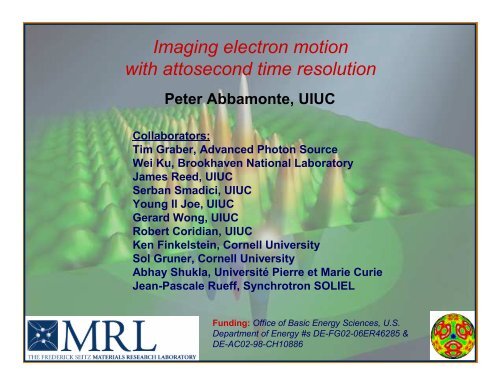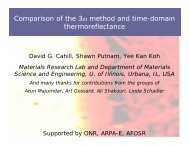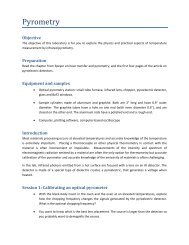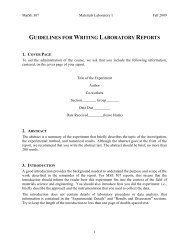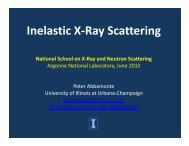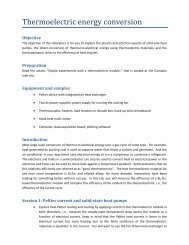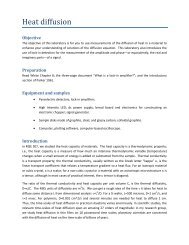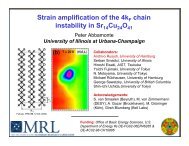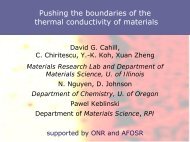Imaging electron motion with attosecond time resolution
Imaging electron motion with attosecond time resolution
Imaging electron motion with attosecond time resolution
You also want an ePaper? Increase the reach of your titles
YUMPU automatically turns print PDFs into web optimized ePapers that Google loves.
<strong>Imaging</strong> <strong>electron</strong> <strong>motion</strong><br />
<strong>with</strong> <strong>attosecond</strong> <strong>time</strong> <strong>resolution</strong><br />
Peter Abbamonte, UIUC<br />
Collaborators:<br />
Tim Graber, Advanced Photon Source<br />
Wei Ku, Brookhaven National Laboratory<br />
James Reed, UIUC<br />
Serban Smadici, UIUC<br />
Young Il Joe, UIUC<br />
Gerard Wong, UIUC<br />
Robert Coridian, UIUC<br />
Ken Finkelstein, Cornell University<br />
Sol Gruner, Cornell University<br />
Abhay Shukla, Université Pierre et Marie Curie<br />
Jean-Pascale Rueff, Synchrotron SOLIEL<br />
Funding: Office of Basic Energy Sciences, U.S.<br />
Department of Energy #s DE-FG02-06ER46285 &<br />
DE-AC02-98-CH10886
Femtochemistry<br />
1<br />
*<br />
2<br />
2<br />
NaI( Σ0)<br />
→ [Na ⋅⋅⋅ I] → Na( S<br />
1/2)<br />
+ I( P3/<br />
2)<br />
P. Cong, et. al., J. Phys. Chem., 100, 7832 (1996)<br />
“Is there another domain in which the race against <strong>time</strong> can continue to be pushed Subfemtosecond<br />
or <strong>attosecond</strong> (10 -18 s) <strong>resolution</strong> may one day allow for the direct observation<br />
of the <strong>electron</strong>’s <strong>motion</strong>. … In the coming decades we may view <strong>electron</strong> rearrangement,<br />
say, in the benzene molecule, in real <strong>time</strong>.” – Ahmed Zewail, 2000 Nobel Address
Attoscience<br />
Reproduced from Drescher, et. al., Science, 291 1923 (2001)<br />
• Events preceding photofragmentation<br />
• Quasiparticle “birth” in semiconductors<br />
• Inner shell processes (shape resonances)<br />
• Electron transfer chemistry
Press
Why not energy domain - photoabsorption<br />
∆t = 100 <strong>attosecond</strong>, ∆E·∆t = ħ /2 ⇒<br />
∆E = 6.58 eV<br />
grating<br />
slit<br />
counter<br />
lamp<br />
specimen<br />
I( ω)<br />
= exp[ −µ ( ω)<br />
L]<br />
µ ( ω)<br />
⇒ ε(<br />
ω)<br />
ε(<br />
ω)<br />
−1<br />
χ<br />
e(<br />
ω)<br />
=<br />
4π<br />
P( ω)<br />
= χ ( ω)<br />
E(<br />
ω)<br />
e<br />
P(t)<br />
E(t)<br />
∫ ∞ −∞<br />
P( t)<br />
= dt′<br />
χ ( t − t′<br />
) ( t′<br />
e<br />
E )<br />
t 0<br />
<strong>time</strong> (as!)<br />
“…energy-domain measurements on their own are – in general – unable to provide detailed insight<br />
into the evolution of multi-<strong>electron</strong> dynamics.” – M. Drescher, et. al., Nature (2002)
Inelastic x-ray (or n + or e – ) scattering<br />
(k 2 ,ω 2 )<br />
(k 1 ,ω 1 )<br />
Fluctuation-Dissipation theorem:<br />
Bell Jar<br />
I(k,ω) ~ – Im[χ(k,ω)]<br />
k = k 1 – k 2<br />
Pendulum<br />
ω = ω 1 – ω 2
Inelastic x-ray (or n + or e – ) scattering<br />
Couple light to <strong>electron</strong>s<br />
(Lorentz force law)<br />
Be sure to second-quantize to get photons<br />
Multiply out to get interactions<br />
Do perturbation theory (1st Born approximation)<br />
Turns out to be a Green’s function
What is χ(k,ω)<br />
χ(k,ω) :<br />
• density-density Green’s function<br />
• density propagator<br />
• susceptibility<br />
Describes how disturbances in <strong>electron</strong> density travel about the medium.<br />
(x,t)<br />
Causality<br />
Same as a pump-probe experiment.<br />
Dynamics is dynamics<br />
(0,0)
“Phase problem” and the arrow of <strong>time</strong><br />
Cannot invert <strong>with</strong> only Im[χ(k,ω)]<br />
Im[ω]<br />
× × × × × × × × × Re[ω]<br />
× × × × × × × × ×<br />
• χ(x,t) = 0 for t < 0<br />
• Raw spectra do not really describe dynamics – no causal information<br />
• Must assign an arrow of <strong>time</strong> to the problem. Permits retrieval of χ(x,t) –<br />
view dynamics explicitly.
IXS - practical<br />
Backscattering<br />
analyzer<br />
Monochromatic<br />
beam<br />
White beam from APS undulator<br />
scattering<br />
angle<br />
Specimen (H 2<br />
O)<br />
K. D. Finkelstein, P. Abbamonte, V. O. Kostroun, Proc. SPIE Int. Soc. Opt. Eng. 4783, 139 (2002)
Plasma oscillations in water<br />
– Im[χ(k,ω)] (as/Å 3 )<br />
• 8 valence <strong>electron</strong>s / molecule<br />
• ρ = 1 g/cm 3 ⇒ n = 0.20 e/Å 3<br />
• ω p<br />
= √(4πne 2 /m) = 16.6 eV<br />
• k max<br />
= 4.95 Å -1 ⇒ dx = 0.635 Å<br />
• ω max<br />
= 100 eV ⇒ dt = 20.7 as
Problems<br />
Problem #1:<br />
Im[χ(k,ω)] must be defined on infinite ω interval for continuous <strong>time</strong> interval<br />
Solution:<br />
Extrapolate.<br />
Side effects:<br />
• χ(x,t) defined on continuous (infinitely narrow) <strong>time</strong> intervals.<br />
• Time “<strong>resolution</strong>” ∆t N = π/Ω max<br />
• Ω max plays role of pulse width.
Problems<br />
Problem #2:<br />
Discrete points violate causality<br />
Im[χ(k,ω)] must be defined on continuous ω interval. Periodicity incompatible <strong>with</strong><br />
causality.<br />
Solution:<br />
Analytic continuation (interpolate)<br />
Side effects:<br />
• χ(x,t) defined forever. Vanishes for t < 0.<br />
• Repeats <strong>with</strong> period T = 2π/∆ω = 13.8 femtoseconds<br />
• ∆ω plays role of rep rate
Nyquist’s (critical sampling) theorem<br />
f(t)<br />
|f(ω)| 2<br />
t<br />
− ω max<br />
ω max<br />
ω<br />
ω N = 2 ω max<br />
Nyquist frequency<br />
ω too small<br />
⇒ aliasing<br />
∆t N<br />
= 20.7 as<br />
∆x N<br />
= 0.635 Å
Disturbance from a point perturbation.
Disturbance from a point perturbation – frame-by-frame<br />
0.1 Å -6<br />
Units Å -6<br />
clipped at 1 Å -6<br />
0.005 Å -6<br />
∆t N<br />
= 20.7 as<br />
∆x N<br />
= 0.635 Å<br />
• Events transpire in 350 as – light travels 100 nm in vacuum<br />
• Causality Analytic properties Rise of entropy Arrow of <strong>time</strong>
Compound sources<br />
(x,t)<br />
(x 0 ,0)<br />
(x 1 ,0)
Compound sources – oscillating dipole
Compound sources – wake from 9 MeV Au ion<br />
• Phys. Rev. Focus, 14 June 2004<br />
• Chemical & Engineering News, 82, 5 (2004)
Excitons: Frenkel vs. Wannier<br />
conduction band<br />
valence band<br />
Frenkel (Xe, Organics, …)<br />
Wannier (Si, Ge, Cu 2<br />
O, …)<br />
J. Frenkel, Phys. Rev., 37, 17 (1931) G. H. Wannier, Phys. Rev., 52 191 (1937)
Alkali halides – an intermediate case<br />
“Excitation” model<br />
Dexter, D. L., Exciton models in alkali halides, Phys. Rev. 108,<br />
707-712 (1957)<br />
It’s all just Wannier<br />
Hopfield, J. J., & Worlock, J. M., Two-quantum absorption<br />
spectrum in KI and CsI, Phys. Rev. 137, A1455-A1464 (1965)<br />
GW correction / Solve Bethe-Saltpeter eqn.<br />
Rohlfing, M., & Louie, S. G., Electron-hole excitations in<br />
semiconductors and insulators, Phys. Rev. Lett. 81, 2312-2315<br />
(1998)<br />
Discovery of excitons in alkali halides<br />
Hilsch, R., & Pohl, R. W., Über die ersten ultravioletten<br />
Eigenfrequenzen einiger einfacher kristalle, Z. Physik 48, 384-396<br />
(1928)<br />
Marginal case btwn. Frenkel and Wannier<br />
Mott, N. F., Conduction in polar crystals. II. The conduction band and<br />
ultra-violet absorption of alkali halide crystals, Trans. Faraday Soc.<br />
34, 500-506 (1938)<br />
Electron transfer model<br />
Overhauser, A. W., Multiplet structure of excitons in ionic crystals,<br />
Phys. Rev. 101, 1702-1712 (1956)
Frenkel vs. Wannier in <strong>time</strong>-domain IXS<br />
Wannier’s Excitonic Basis:<br />
| R, R + β ><br />
Excitons come from diagonalizing<br />
∑<br />
K<br />
ββ ′<br />
′<br />
R<br />
−i<br />
⋅R<br />
H ( K) = e < R, R + β | H | 0, β ><br />
For Frenkel exciton, dominated by one term:<br />
∑<br />
K<br />
R<br />
( ) −i<br />
⋅R<br />
H , | | 0,0<br />
00<br />
K = e < R R H ><br />
Conclusion: Frenkel exciton keeps its size / shape through its life. Wannier<br />
changes. Inverted IXS directly sensitive to Wannier vs. Frenkel vs.<br />
intermediate descriptions.
Result
Time response<br />
All processes:<br />
• Exciton<br />
• Interband<br />
• Plasmon<br />
• Core levels<br />
• Compton<br />
scattering
Isolating the exciton<br />
g<br />
gap<br />
B<br />
( ω)<br />
= 1 + e<br />
k<br />
k<br />
g<br />
−W<br />
( ω−ω<br />
)<br />
Im[ χ ] = Im[ χ ] −g<br />
( ω )<br />
e,<br />
n n gap n<br />
⎧<br />
Im[ χne,<br />
n]<br />
= ⎨<br />
⎩<br />
g ( ω ) ω < ω<br />
gap n n c<br />
Im[ χ ] ω ≥ ω<br />
n n c<br />
Truncated at 16.5 eV
Exciton dynamics<br />
Frenkel limit.
Wannier functions (Ku, et. al.)
Lessons<br />
•Exciton in LiF is Frenkel, despite the old controversy.<br />
•No contradiction between CT and Frenkel. Lattice geometry not a<br />
constraint.<br />
•Causality allows solution to “phase problem” for IXS ⇒ zeptoseconds!<br />
•Is there information in this which cannot be read off the raw spectra!<br />
1. Extrapolation 2. Causality<br />
• χ(x,t) useful for analyzing extended sources
Homogeneous vs. homogeneous broadening
Graphite<br />
Wallace, Phys Rev. 71, 622 (1947)<br />
σ,π plasmon<br />
Compton<br />
scattering<br />
π plasmon


